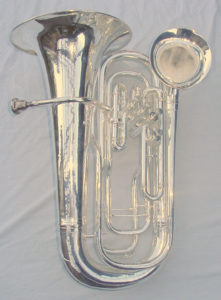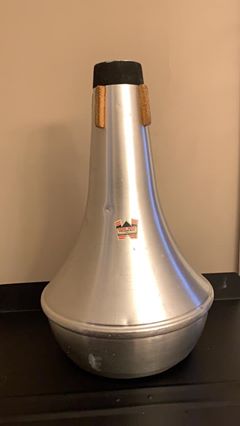14 The Euphonium
The euphonium is the newest standard member of the brass family having been invented in the 1840s. It was developed as an immediate response to the development of valves, as it was seen as a melodic low voice with a warmer sound than the trombone. In terms of voicing, it serves the same role as the trombone as a tenor or baritone voice. The youth of the euphonium can be seen in the many different variations of design that are used by different manufacturers of the instrument.

The euphonium is closely related to the baritone, and the distinction between the instruments can be somewhat unclear. In practice, the instruments’ names are often used interchangeably, though differences do technically exist. The baritone originates in the British brass band and is smaller and more compact, as part of the same instrument family as the now-antiquated alto horn, voiced a 4th higher. The British euphonium has a more conical bore and a fuller tone than the baritone. In the United States during the first half of the 20th century, the American baritone was actually a hybrid of the British baritone and euphonium. The bell front American baritone was a fixture of the first half of the 20th century, but more recently, the British style euphonium has risen to prominence in both school and professional bands over the American baritone. It serves a versatile role in the ensemble, including as a melody instrument, tenor voice accompaniment, and bass line.

Characteristics for Beginning Euphonium Players
It should be noted that the best instrument for a student is the instrument that the student wants to play. This is no different for the euphonium. With very few exceptions, any student can be an effective euphoniumist.
The euphonium is quite possibly the most forgiving instrument of all for beginners. While mastering the instrument takes a great deal of time due to the wide range of musical expectations for the instrument, the instrument’s size makes it appropriate for nearly any musician and the embouchure is very accommodating to orthodontic issues.
The one challenge that beginning musicians often have with the euphonium is the large amount of air required for full tone. The construction of the instrument is very free blowing, so it requires a large amount of consistent air to maintain good tone.
The euphonium makes an ideal transfer instrument for students who have encountered physical issues with other instrument. In particular, high brass players with braces often make extremely strong euphonium players as the musical demands of euphonium as a melody instrument are often similar but the larger mouthpiece reduces pressure on the face
Setting Up the Euphonium
While there are several designs for the euphonium, nearly all have the same fundamentals in terms of posture. The left arm supports the weight of the instrument while the right hand manipulates the valves and stabilizes the angle of the instrument.
For instruments with a compensating valve, the left arm wraps around the front of the euphonium so that the left index finger can press the compensating valve. The left arm is less responsible for holding the euphonium up as it is for creating leverage against the lower torso on which the euphonium rests. Importantly, students should establish their posture first and then bring the euphonium to themselves. Except for extremely small players, the euphonium should not be resting on the lap. If a student finds the weight of the instrument difficult to support, they may position a cushion under the instrument, making sure that the height of the cushion allows for proper torso posture.
The right hand should be in the shape of a C with the thumb positioned under the valve brace and the fingers positioned on the fingertips on the valve caps. Care should be taken to make sure that the fingers stay close to their assigned valve and do not wander together or curl back toward the palm of the hand.
When bringing the instrument to the body, make sure that the torso and head are in position first. The mouthpiece should rest in the center of the lips roughly evenly divided between the upper and lower lips. The mouthpiece cushion should remain very relaxed and supple to allow for a very free and vivacious buzz.
The exact angle of the instrument is based in part on the player’s body and size. The euphonium typically leans slightly to the right while playing at an angle that allows the left arm to comfortably wrap around the instrument and the right arm to come up to the valves without compressing the rib cage or pulling the shoulder out of line.
Euphonium-specific Details and Concepts
As mentioned in the previous chapters, many of the details of euphonium playing are common to all brass playing concerning technique, tone, and practice. Make sure to reference the general sections regarding each of these issues in addition to the euphonium specific details below.
Range development
As with all brass instrument, range development tends to be slow compared to woodwind and string instruments. While most players find that the first sound on euphonium comes very easily, it can take beginning euphoniumists a fair amount of time before they are able to play a full octave across three partials. It is critically important that beginners are not pushed too quickly to develop range and that they are encouraged to play long tones and interval studies that can develop their muscle tone and control.

Follow this link for a Euphonium Fingering Chart.
Intonation control
Intonation on euphonium is primarily controlled through the embouchure, though many instruments include a 4th valve or a compensating system that allows for more in tune alternatives to problematic fingering combinations.
BC vs. TC Euphonium/Baritone
Because of its frequent use as a transitional instrument from trumpet and the varied uses of the euphonium in the British brass and concert bands and the American concert band, the euphonium is frequently written in both bass clef (BC) and treble clef (TC) parts. Importantly, in almost all instances, BC and TC parts are identically the same in pitch, but their notation can be confusing. Similarly, parts may be written for either baritone or euphonium, but in practice, the same physical instrument will typically play the part.
In modern notation, BC parts are written in concert pitch, along with all other low brass instruments. The notated bb2 on the second line of the bass clef is played as a concert bb2 with an open fingering position.
By contrast, the TC euphonium or baritone is a Bb transposing instrument. Additionally, it is written a major 9th higher than it sounds. The notated c4 on the ledger line below the treble clef staff sounds as a concert bb2 and is fingered with open fingering. The benefit of this system is that it allows trumpet players who are transitioning to euphonium to use the same fingerings as trumpet. For the experienced euphonium player, they should be comfortable with reading notation for both Euphonium/Baritone TC and BC, though they will typically prefer reading from a BC part.
4th valve vs. Compensator systems
Two different systems commonly exist on euphoniums to adjust particularly out of tune intervals and extend the full chromatic range of the instrument. On the surface, they work in very similar ways. The 4th valve or compensator system serves to provide an alternative fingering for 1-3 and 1-2-3 fingerings and fill in the gap between the fundamental of bb1 and e2. The way these systems function is distinctly different and has ramifications for in tune playing and for extreme low register.
4th valve
The fourth valve is typically positioned alongside the first three valves and functions exactly the same way as the other valves on the instrument by lowering the pitch by a fixed amount, in this case, a perfect 4th when descending from an open fingering. The 4th valve can be used as a substitute for the 1-3 fingering combination and can provide an imperfect partial between the fundamental Bb and first partial Bb. The problem develops as the low Bb is approached as the tubing is not quite long enough to compensate for register and the incorporation of the other three valves, causing the pitch to sit relative sharp.
Compensating system
Compensating systems work by a more complex but more effective system. The compensating valve is typically found on the side of the euphonium. When pressed, the compensating system opens up an additional set of tubing that is attached to each valve. This system compensates for the additional tubing needed not only for the initial interval of the perfect fourth, but also the additional tubing needed for each additional depressed valve. This compensating system is preferred over the 4th valve system as it allows for better intonation as more valves are depressed in the low register, allowing for a smooth connection to the fundamental Bb.
For an outstanding video explanation of how compensating systems function, check out this explanation by David Werden.
Mutes
Mutes are seldom used in concert literature for the euphonium. When called for, the straight mute is most commonly used for the euphonium. It is inserted while the instrument is vertical in playing position by reaching over the top of the instrument to place it in the bell.

Unique Issues for Euphonium
Air support issues-Due to the large size of the euphonium, air support is a frequent problem for more novice euphonium players. Students should work on building both lung capacity and exhale capacity and consistency. Exercises found in the Breathing chapter can help students build this capacity.
Technical dexterity-The large size of the valves coupled with the melodic responsibilities of the euphonium can pose problems with technical dexterity. Students should be reminded to maintain a rounded C shape in the right hand so that the finger tips are on the valves. By keeping the fingers rounded and on the valve buttons, students are better prepared for quick movements. Euphonium players should also include technical exercises such as Dexterity Exercise #1 and Dexterity Exercise #2 as part of their every day practice.

